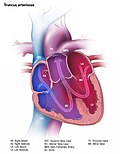Persistent truncus arteriosus: Difference between revisions
CSV import Tags: mobile edit mobile web edit |
CSV import |
||
| Line 27: | Line 27: | ||
{{stub}} | {{stub}} | ||
<gallery> | |||
File:Truncus_arteriosus.jpg|Persistent truncus arteriosus | |||
File:TruncusArteriosus.svg|Diagram of truncus arteriosus | |||
File:Gray469.png|Gray's anatomy illustration of truncus arteriosus | |||
</gallery> | |||
Revision as of 01:14, 18 February 2025
Persistent truncus arteriosus (PTA) is a rare form of congenital heart disease that presents at birth. In this condition, instead of having separate vessels to carry blood from the heart to the lungs and the rest of the body, there is only one common blood vessel or truncus.
Signs and Symptoms
Infants with PTA often show signs of heart failure within the first few weeks of life. These can include rapid breathing, poor feeding, and failure to gain weight. Other symptoms may include a bluish coloration of the skin and lips (cyanosis), fatigue, and poor circulation.
Causes
PTA is caused by a defect in the development of the heart during the first 8 weeks of pregnancy. The exact cause is unknown, but it is thought to involve a combination of genetic and environmental factors.
Diagnosis
Diagnosis of PTA is usually made shortly after birth, based on the infant's symptoms and a physical examination. This can be confirmed by echocardiography, which can show the single vessel coming out of the heart, and other associated heart defects.
Treatment
Treatment for PTA involves surgery to separate the single large vessel into two separate vessels, one for the lungs (pulmonary artery) and one for the body (aorta). This is usually done within the first few weeks of life. Medications may also be used to help manage symptoms before surgery.
Prognosis
With early diagnosis and treatment, the prognosis for children with PTA is generally good. However, they will need lifelong follow-up care with a cardiologist to monitor their heart function and manage any complications.





